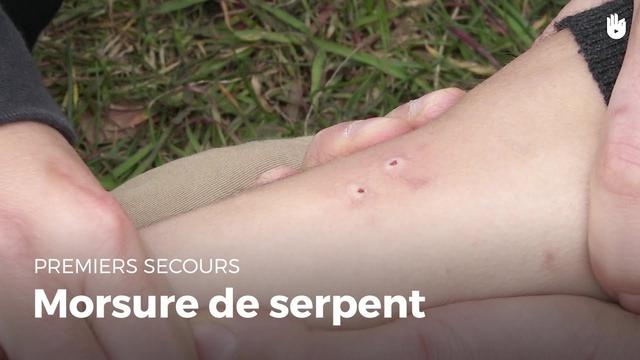Do you like our Planet Files? Subscribe to the Planet Files newsletter to receive it twice a month.
Schematically, a distinction is made between etiological treatment, which aims to neutralize the venom, and symptomatic treatment, the objective of which is to reduce the clinical signs that accompany envenomation.
Green boa: its color allows it to blend into the foliage of trees. © PetlinDmitry, Shutterstock
Three levels of intervention must be distinguished: at the site of the bite (first aid), in outlying medical posts or surgeries without special means (emergency treatment) and intensive care units reserved for the most severe cases ( resuscitation and treatment of complications).
FIRST AID
The first thing to do is reassure the victim and avoid panic. If you have the necessary equipment, you can clean the bite. Try to immobilize the limb with a loose bandage (Velpeau bandage, scarf gauze, etc.).

It is essential to avoid dangerous gestures: burning the wound with a flame or an incandescent object, direct application of ice or aggressive chemical products, incisions or tourniquet. These gestures, most often useless, are always dangerous. Finally, the patient will be evacuated to the nearest health center as quickly as possible.
Naja nigricollis: African spitting cobra. “After spitting cobra venom splashes into the eye, it should be rinsed thoroughly with clean water. Analgesic and antiseptic eye drops will be applied, but never antivenom. »
Emergency treatment
Intensive care
They are the responsibility of the specialist who may possibly continue the serotherapy. The treatment of hemorrhagic syndrome and/or severe anemia by blood transfusion or administration of blood products is only justified once the venom has been completely eliminated thanks to antivenom serum.
Antivenom Serum
Antivenom serum is made up of the antibodies of an animal, most often the horse, produced following repeated injections of increasing amounts of venom. Antivenom serum is therefore only effective against the venoms that were used to make it. New generation serums, highly purified, are perfectly effective and well tolerated. Adverse effects are usually mild and their frequency is around 5%.
Gradually, manufacturers are abandoning the manufacture of monovalent serums, prepared against the venom of a single venomous species, except for a few species responsible for a large number of envenomations (the Viperidae Echis ocellatus from the savannahs of sub-Saharan Africa), island ( Bothrops lanceolatus from Martinique), or widely dispersed geographically (Crotalus durissus in Latin America or Vipera berus in northern Europe). The trend is rather towards the marketing of polyvalent serums, bringing together the most frequent and dangerous species from a more or less extensive geographical region (Sub-Saharan Africa, Maghreb, Middle East, Southeast Asia, etc.) or from a family on the scale of a continent (Anti-American Bugloss, anti-European Bugloss, anti-Australian Elapidae).
Antivenom should be given intravenously as soon as possible after the bite. Its duration of action is several hours. The dosage depends on the quantity of venom inoculated, which is obviously never known but can be evaluated by the clinical symptoms both in terms of the speed of appearance of the signs and their severity.
An antivenom must be effective, i.e. capable of effectively neutralizing the venoms against which it is prepared, well tolerated to avoid adding to the symptoms of envenomation those of an allergy, stable in order to be able to be stored without loss of efficacy or tolerance while waiting to be administered, and accessible. Stability and preservation are obtained by lyophilization. The problem of accessibility is particularly sensitive in developing countries, the most affected by envenomation. Cost is obviously a key aspect, as the price of an ampoule of antivenom exceeds the average monthly income of victims and there is no provision for reimbursement. Product availability is also a major issue. It is usual for anti-venom serums to be kept in central purchasing offices in the capital while waiting to be ordered by pharmacies unwilling to lose their stock. Sometimes available in large hospitals, antivenom serums are absent from peripheral health centers which, however, receive the majority of poisoning accidents, for lack of a cold chain or personnel deemed capable of using them.
Management of snakebites
Access to care is a recurrent problem in the majority of developing countries. Health centers are scattered and under-equipped. Caregivers are overwhelmed and rarely benefit from up-to-date relevant medical information. Added to all this is the economic crisis and civil or military insecurity; the adequate management of patients is therefore particularly difficult. As a result, public confidence in the health system is constantly eroding, which partly explains why less than 30% of patients on average are treated in health centers according to modern medical standards.
Previous page - 5/7Symptoms of envenomationsNext page - 7/7Conclusion
360 Caméra Vidéo Market Size & Share 2022 – Global Business Review, Key Findings, Forecast by Regions, Growth Strategy, Developing Technologies, Trends and Company Profiles – Sphericam Inc, Panono, Bubl, Samsung – athleduweb.be
Yubico unveils its security key with fingerprint reader
5 Bonnes Raisons d’Acheter La Huawei Watch Fit Special Edition Noir
Comment Utiliser le Honor Magic 6 Lite et MagicOS 7.2 : Combinaison Parfaite de Technologie et D'humanité